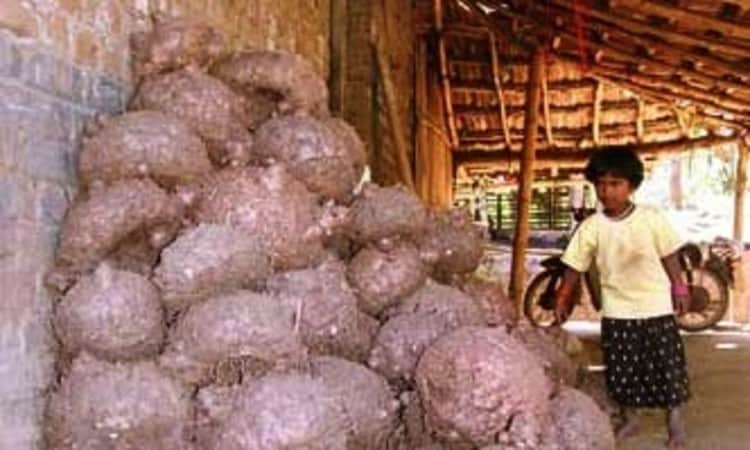Elephant foot yam, Amorphophallus paeoniifolius, is a tropical tuber crop that has been in cultivation throughout tropical Asia for centuries. It is harvested for its corms, tubers, and smooth petioles, all of which are edible and contain key minerals. This plant is given its name because it is quite large and resembles the foot of an elephant. Stinking Snakeskin Lily, Whitespot Giant Arum, Pungapung and Voodoo Lily are some of many other names it goes by in different areas of the world.
Much of the elephant foot yam can be eaten. When the leaves of the plant wither and die, the corm, or tuber, can be dug up and eaten. Usually it is cooked and eaten as a vegetable, and in many places it is smashed with salt and eaten with rice. The young unopened leaves and young petioles (leaf stalks) are edible cooked, and are often served with fish. It also serves as the base for many curries, chutneys, kebabs, and sweet dishes, or can be fried into chips.
In Indonesia, the tubers are the third most important carbohydrate source after rice and maize. They are also consumed widely in India and Sri Lanka, although elsewhere they are seen as a famine crop, to be used when more popular crops, such as rice, are in short supply. Elephant foot yams are a good source of vitamin B6, are high in fiber and in omega 3 fatty acids, help to reduce cholesterol levels in the body and contain anti-coagulating properties that can prevent blood clotting. They are also loaded with potassium, magnesium and phosphorous, as well as with trace minerals like selenium, zinc and copper.
While further research is needed to determine the pharmacological properties of the elephant foot yam, it has medicinal properties and is used in many Ayurvedic (traditional Hindu) preparations. According to Kew Royal Botanical Gardens, “the tubers are considered to have pain-killing, anti-inflammatory, anti-flatulence, digestive, aphrodisiac, rejuvenating and tonic properties. They are traditionally used in the treatment of a wide range of conditions including parasitic worms, inflammation, coughs, flatulence, constipation, anemia, hemorrhoids, and fatigue.”
Interested in preparing elephant foot yam? Take a look at these recipes!
Recipe for Elephant Foot Yam Kootu
Prep time: Approx. 15 mins
Cook time: Approx. 30 mins
Serves – 3-4
Ingredients needed
Elephant foot yam – 2 cups chopped or 1/4 kg
Tur dal – 1/3 cup
Tamarind – a small gooseberry sized ball
Turmeric powder – 1/4 tsp
Salt needed
For grinding
Coriander seeds – 1 tbsp
Bengal gram/channa dal/kadalai paruppu – 2 tsp
Red chillies – 4
Grated coconut – 1/4 cup
Raw Rice – 1 tsp
For the seasoning
Oil – 1 tsp
Mustard seeds – 1 tsp
Hing – a pinch
Curry leaves – few
Preparation
Peel the skin, wash and chop the elephant foot yam into small pieces. Wear disposable gloves or grease your hands with oil before cutting yam as some varieties itches the skin.
Heat oil in a kadai (deep cooking pot), add coriander seeds, channa dal, red chillies, raw rice and saute until dal turns golden brown. Add grated coconut, fry for a few seconds and switch it off. Saute in the heat of the pan itself. Once it cools, grind it to a smooth paste.
Pressure cook dal for 3 whistles or until soft. Mash it well and keep it aside. (Soaking dal in hot water for 15-20 minutes prior to cooking saves a lot of time and fuel. The dal also gets cooked well.)
Soak tamarind in a cup of warm water for 15 minutes. Extract tamarind juice and discard the pulp.
Method
- Cook senai/yam in 1 cup of water, adding salt and turmeric powder. Once the yam is half cooked, add 1 cup of tamarind water and cook until the raw flavor of the tamarind goes and the yam becomes soft.
- Once the yam is cooked well, add the ground paste.
- Add the cooked dal, 1/2 -3/4 cup of water and cook simmered until everything gets blended well. Check for salt.
- Heat a tsp of oil, add mustard seeds, when it splutters, add hing, curry leaves and pour it over the kootu. Serve with hot steamed rice.
With plain rice and any thogayal it makes a filling meal.
Note – Senai has to be cooked properly in tamarind water, otherwise it might cause itching sensation in the mouth also.











